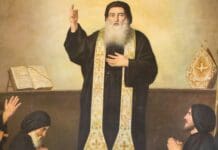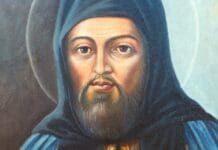By Phillip Rolfes
“The Latin church originated from the Greek church as a branch grows from a tree trunk.”
I’ll admit, that quote stopped me dead in my tracks when I first read it. I had to go back and read it a few times to really let it sink in. And the surprising thing? It was written by a Roman Catholic cardinal!
The full quote comes from the book The Spirituality of the Christian East by Tomas Cardinal Spidlik (a book I highly recommend if you’re at all interested in diving into the spirituality of the Christian East). “We must stress one principle and stress it hard” he says, “the Latin church originated from the Greek church as a branch grows from a tree trunk. The Church was implanted by the Greeks and expressed itself in the greek [sic] language until the end of the fourth century.”
We in the 21st century have become so accustomed to equating the Catholic Church with the Roman Catholic Church, using those two titles synonymously, that reading such a statement can be jarring at first. After all, the Church in Rome has, for so long, held the central role of influence over the Catholic Church, it’s easy for us to fall into the misunderstanding that our Faith originated in Rome.
But nothing can be further from the truth.
Pope St. John Paul II reminded us of this in his Apostolic Letter Orientale Lumen. In it he says, “My gaze turns to the Orientale Lumen (Jesus Christ) which shines from Jerusalem, the city where the Word of God, made man for our salvation… died and rose again.” The saintly pope then reminded us that it was from Jerusalem that the Church spread first throughout the Greek-speaking Mediterranean and Asia Minor, before making its way into the heart of the Roman Empire, Rome itself.
And, as the Second Vatican Council was very adamant to remind us, the basic beliefs of the Catholic Faith that we profess every Sunday in the Creed (more properly known as the Nicene or Nicene-Constantinopolitan Creed) were hammered out in the East: “the basic dogmas of the Christian faith concerning the Trinity and the Word of God made flesh from the Virgin Mary were defined in ecumenical councils held in the east.”
It was in the Greek-speaking East that our beliefs about God as Trinity, the relationship between Jesus’ divine and human natures, our understanding of the Holy Spirit, and our belief in Mary as the Mother of God were formed. And to this day you can hear remnants of this Greek influence in the Roman Catholic Mass every time you sing Kyrie eleison, Christe eleison. Those are Greek phrases!
Finally, take a quick look at the 36 “Doctors of the Church,” those theologians whom Rome itself has said have had a formative impact on the Church’s thought. You’ll find that nearly 1/3 of them are from the East:
1. Athanasius
2. Basil the Great
3. Cyril of Alexandria
4. Cyril of Jerusalem
5. Ephraim (of Nisibis) the Syrian
6. Gregory Nazianzus
7. John Chrysostom
8. John of Damascus
9. Gregory of Narek (an Armenian)
That’s 9 out of 36 Doctors of the Church who come from the East! And, as a side note, St. Thomas Aquinas himself often quotes St. John of Damascus in his Summa Theologiae—referring to him affectionately as “the Damascene.”
So is Tomas Cardinal Spidlik’s comment at the beginning of this article an exaggeration? The Church doesn’t think so! Which is why Pope St. John Paul II himself said that “the first need for Catholics is to be familiar with that (the Eastern) tradition,” and that the “members of the Catholic Church of the Latin tradition must also be fully acquainted with this treasure.”
 Phillip Rolfes is That Eastern Catholic Guy. A “canonical convert” from Roman Catholicism to Maronite Catholicism, Phillip loves researching and sharing the rich traditions of the Christian East. He lives in Cincinnati, OH. with his wife and four children, and is parishioner at St. Anthony of Padua Maronite Catholic Church.
Phillip Rolfes is That Eastern Catholic Guy. A “canonical convert” from Roman Catholicism to Maronite Catholicism, Phillip loves researching and sharing the rich traditions of the Christian East. He lives in Cincinnati, OH. with his wife and four children, and is parishioner at St. Anthony of Padua Maronite Catholic Church.


















[…] Francis Proposes Considering A ‘Universal Basic Wage’ – Cthlc News Agency via Newsman Surprising, but True: Latin Church Actually Originated From the Greek Church – uCatholic Live-Streaming the Absurdity of Versus Populum & the Prayerfulness of Ad […]
The diagram at the top of this article helps to clarify some confusion that might arise in a reader of this article. It is clear that all the rites of the Church ultimately find their birthplace in Jerusalem. However, it would be a mistake to think that Paul or the other Apostles saw themselves as Greeks. The common language of that part of the Mediterranean world was Greek (though everybody else also had their own local languages). However, it would be a mistake to call the Church in Jerusalem a Greek church at the time. Your diagram correctly shows the dependence on Jerusalem. The fact that there were Greek speakers in many areas of the Mediterranean doesn’t make them Greeks. Peter and Paul would have never seen themselves as Greeks even if the New Testament was written in that language.
Look East, is an age old saying. Christianity, Judaism, Islam, Buddhism, Hinduism, Jainism, Zoroastrianism, Taoism, Shintoism, they all have their origin in the East.
A further thought comes to me as I study the diagram. The Greek rite would seem to begin from Constantinople in the diagram. As most readers know, the eastern capital of the Roman Empire is from the fourth century. If the diagram is supposed to represent the origin of the various rites, you would have to name an earlier city of origin, but in fact we see that already at the time of St. Paul there were many Greek cities that he had been evangelized so Constantinople would certainly not be the “mother” Church. The Greek rite would stem directly from Jerusalem. The prominence of Constantinople arose much later as the capital of the Eastern Roman Empire.
Micky T. Huddson Make 6150 bucks every month… Start doing online computer-based work through our website. I have been working from home for 4 years now and I love it. I don’t have a boss standing over my shoulder and I make my own hours. The tips below are very informative and anyone currently working from home or planning to in the future could use this website…….. Details Here
Very good article! We are linking to this great post on our website.
Keep up the great writing.